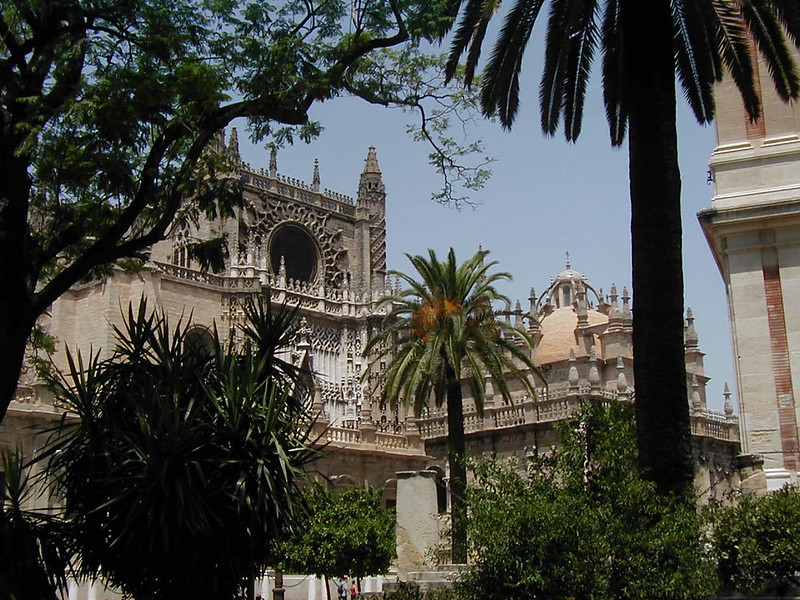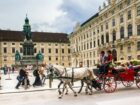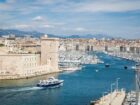Travelers to Spain with limited time often need to choose between staying in Valencia or Seville for a few days. They are similar-sized cities (populations roughly 800k vs 700k), both located in the Southern half of Spain. Both cities have a rich history and have existed since the Roman era.
Which of Valencia or Seville should you choose for 3-4 days? Seville is a beautiful inland city with impressive Moorish Spain era landmarks and districts. It has a unique Andalucian feel with a tradition of Flamenco, wines, and horses. Valencia is a very modern and dynamic Mediterranean port city with nice beaches, a huge and renowned city of arts and science, a unique green belt along the river, and a lively nightlife.
Table of Contents
Valencia or Seville: what travelers say
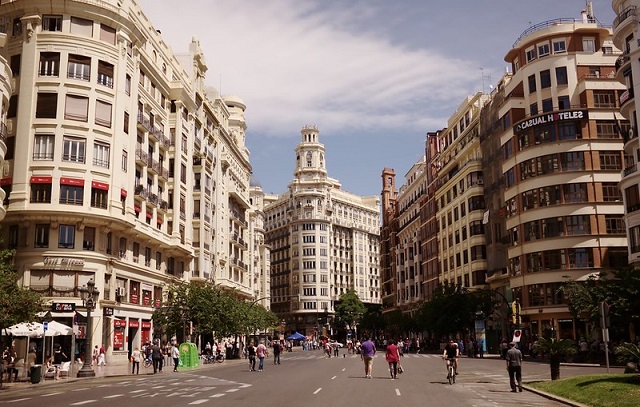
- Many travelers prefer Seville which they feel is one of the most beautiful cities in the world, charged with history and culture. Valencia, on the other hand, is a better choice for beach lovers and nightclubbers.
- Valencia has a bigger, richer, and more modern feel compared to Seville which is more traditionally Spanish and quintessentially Andalusian.
- Seville has unbearable heat in the summer and often into September – some visitors choose to sleep during the day and visit the city at night. Valencia also gets hot in August but not as much, has cooler evenings and beaches for cooling down.
- Seville is more affordable than Valencia and offers great value, including meals and drinks, attractions, and transportation.
- Seville has more prime historical sights than Valencia due to its unique Moorish influence and New World era past. Valencia does have a few significant Baroque landmarks and the massive City of Arts and Sciences, including the impressive Oceanarium.
- In general, any travelers feel Seville has more to see and do and more of a Spanish atmosphere compared to Valencia, including great tapas, shops, and monuments. In Valencia, aside from the beach, some visitors feel they run out of activities after a few days.
- Valencia has a vibrant cosmopolitan nightlife with a great clubbing scene during the warm months. Seville primarily has “typical” Spanish culture including bullfighting, flamenco, sherry, and horses, and large numbers of lively tapas bars open until late at night.
- Valencia has the edge over Seville for classical music including orchestral and operas. Seville, particular the Triana neighborhood, is one of the historical centers of Flamenco music and dance.
- Travelers typically recommend a 3-4 day stay for either Seville or Valencia
Valencia or Seville: access & transportation
Both the Seville airport and the Valencia airport (Manises) are close to the respective city centers (a 5-6 mile drive).
Seville and Valencia are about 400 miles away from each other. The two cities are connected by a high-speed train (AVE) which passes through Cordoba (another stunning historical city of Andalucia) and takes about 5 hours to get from one city center to the other.
Although big, Valencia is quite walkable. It also has an efficient subway system and train service for moving on longer distances.
In Seville, most sights in the center are situated within walking distance, including the Cathedral, the Alcazar, the Parque Maria Luisa, and the Guadalquivir river banks. You can also easily rent a bicycle for days or weeks by buying a card from one of the numerous bike kiosks.
Valencia or Seville: vibe & people
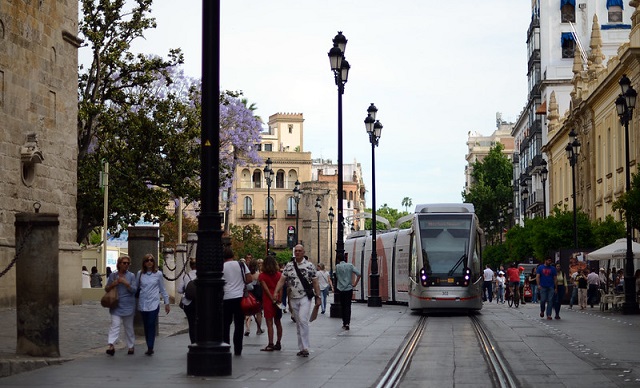
Like other cities in Andalucia, Seville is organized for tourism and has a significant old town, monuments and museums everywhere. Valencia is closer to a typical Mediterranean city albeit with a few historic buildings here and there.
Valencia feels more like a working city, not particularly geared toward attracting tourists. It’s not as polished and picture-perfect as Seville is, which makes it perhaps a bit more authentic. Visitors generally find walking around the narrow streets a pleasant experience.
Likewise, Valencia’s bars and restaurants cater primarily to the locals and have perhaps a slightly more authentic feel compared to the tapas bars in Seville’s historic center which are more touristy. Nevertheless, Seville is hardly a mass-tourism destination and remains a true Andalucian city.
Valencia’s fantastic green belt built around the former Turia river bed and splitting the city in two provides an astonishing calm and soothing atmosphere in the midst of the big city. Seville’s Maria Luisa Park is a beautiful and elegant park, though not nearly as important.
Seville is one of the most attractive tourist destinations in Spain with its picturesque and atmospheric old district, bars, and restaurants. More tourists concentrate in the city center and typically visit the many sights on foot.
When the orange trees blossom in Seville, the streets have an amazing smell that adds to the charm of the buildings. The locals in Seville are generally warm and friendly. However, they don’t generally mix with the tourists so much and mainly hang out in areas other than the old town.
Like other parts of Andalucia, Seville has many of the attractions foreigners think about for Spain – flamenco, bullfighting, Moorish history, tapas, wine, etc.
Valencia or Seville: sights & culture
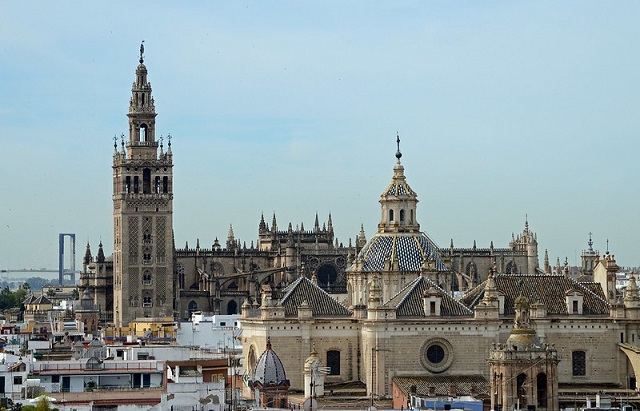
Many travelers favor Seville over Valencia for its impressive Mudejar heritage – a mixed Gothic and Islamic style of architecture from the 12th to 15th centuries, which gives Seville a special aura and atmosphere.
Seville has older churches compared to Valencia, and a much larger cathedral (the biggest in Europe). The cathedral has the magnificent 12th-century Giralda tower, a tall Islamic minaret turned into a bell tower, now a UNESCO World Heritage site.
Climbing the many stairs of the Giralda you’ll get an amazing of the city. Aside from the Cathedral and the Giralda tower, Seville has other grand monuments and sights such as:
- The impressive Royal Alcazar Palace and its lush gardens, a UNESCO World Heritage site rival to Granada’s Alhambra
- Plaza de España, sometimes described as Spain’s most beautiful square with Baroque, Renaissance, and Moorish influence. Located in the gorgeous Parque Maria Luisa.
- Palacio de las Dueñas and Casa de Pilatos, two gorgeous palaces, the former the residence of the Duke of Alba, the latter with wonderful gardens.
- The Museo de Bellas Artes, a major art museum in Spain hosted in a building with impressive architecture
- Iglesia del Salvador, a beautiful Baroque church which can be visited along with the Cathedral.
- The Museum Palace of the Countess of Lebrija and its stunning Roman mosaics
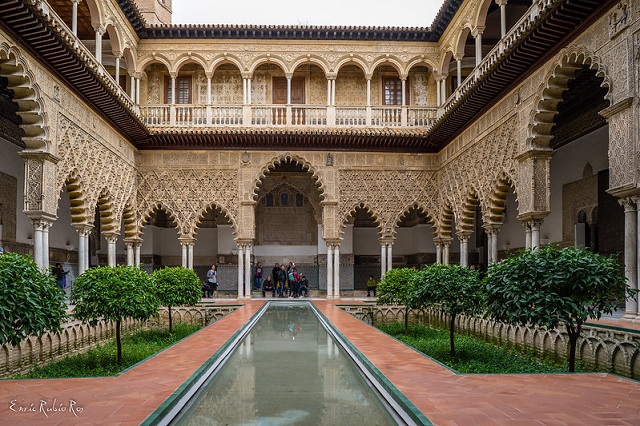
The Cathedral and many of the monuments are located in the Barrio de Santa Cruz, Seville’s historic town and its touristic heart.
The Metropol Parasol on the Plaza de la Encarnacion is a modern (2011) is one of the world’s largest wood structures with viewing platforms that offer spectacular views of Seville.
Valencia’s is most renowned for its City of Arts and Sciences park, a huge modern cultural and architectural complex, considered one of Spain’s 12 Treasures.
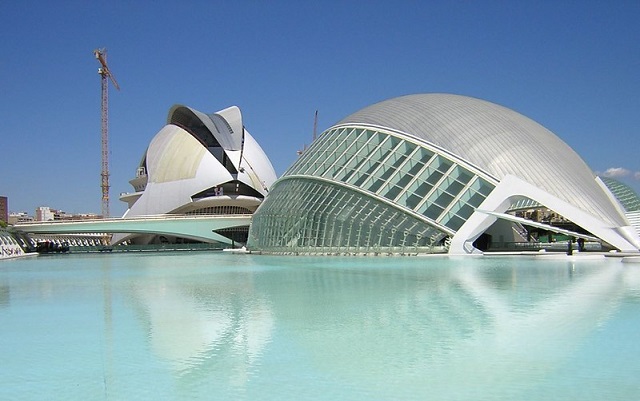
The park includes the largest oceanographic aquarium in Europe with 110.000 m2, an opera house, botanical gardens with sculptures, a science museum, a planetarium and laserium, a large concert hall, a high cable-stayed bridge over the river, and much more.
The Turia Gardens is one of the largest urban parks in Spain, an impressive green belt running through the city along the 6 miles of the former riverbed of the Turia, all the way to the science park. It has walking, running, and bike paths, passing by the city’s main landmarks and museums.
Other major sights in Valencia include the Mercat Central (central market) with its impressive Art Nouveau architectural style, and the 15th-century Llotja de la Seda (silk exchange), a Gothic-style building and a historical center of the silk trade.
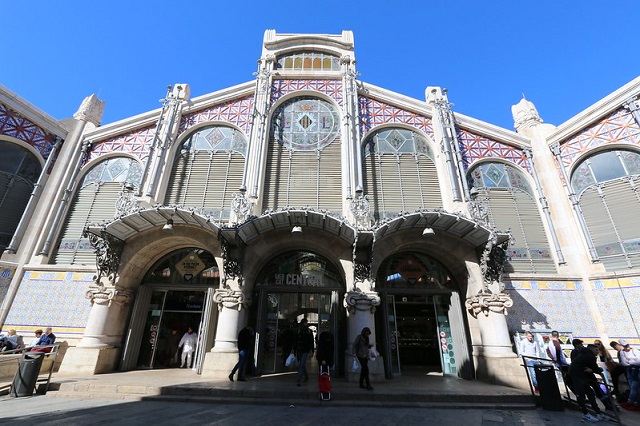
Valencia’s Old Town is also home to worthy monuments such as the 13th to 15th-century Gothic Cathedral, the 15th-century Palau de la Generalitat Valenciana (local government HQ), the Museu de Belles Arts de València and the Institut Valencià d’Art Modern (art museums), and several Gothic-style towers dating back as early as the 14th century.
Valencia or Seville: food & nightlife
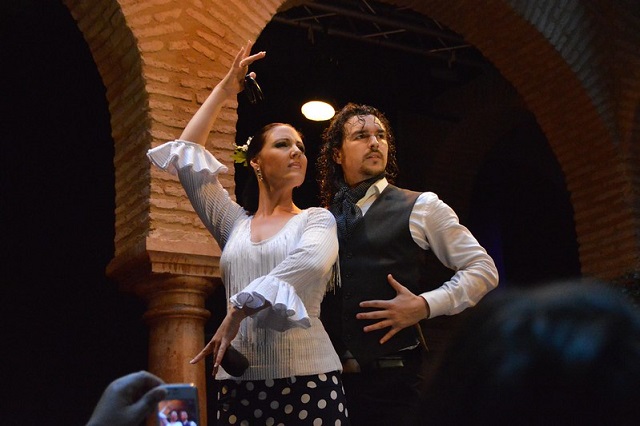
Both Valencia and Seville have a great nightlife. Seville is famous for its tapas culture and Flamenco pubs. Travelers generally love the quality and prices of the tapas in Seville, often more than Valencia.
A lot of the animation in Seville happens around the La Alameda de Hercules, a big square with countless bars overflowing with people on the street at night.
Across the river to Triana is where the locals hang out at night, and the birthplace of Flamenco, where you’ll find the most authentic performances. Other good places for Flamenco include Los Gallos on Plaza de Santa Cruz or Casa de la Memoria.
The Barrio de Santa Cruz (Old Town) is where most tourists hang out. There are many tapas bars on and around Calle Mateos Gago serving octopus and Iberian ham. The narrow streets of the old Jewish quarter also have some good places to have a beer with tapas.
The square outside Iglesia del Salvador (Plaza del Salvador) is another lively and relaxed place to have a drink and fried seafood. On a different note, the EME Catedral Hotel next to the cathedral has a cool rooftop bar and great views.
Restaurants travelers often recommend in Seville include the Cuna (elegant traditional Andalucian place), El Galinero de Sandra (small restaurant with good food), Casa Robles (elegant restaurant close to the cathedral), Restaurante Manolo Leon (nice patio).
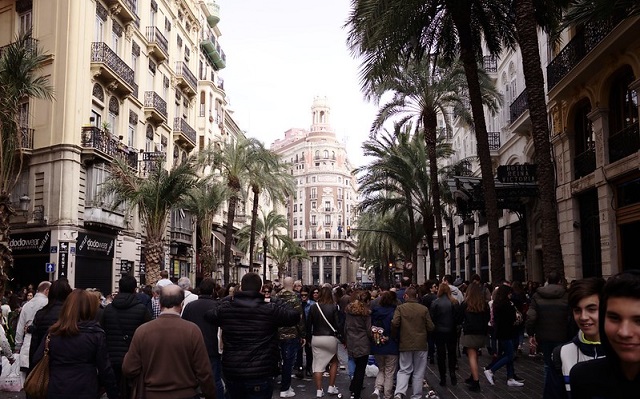
In Valencia as in Sevilla, nightlife starts very late, with dinner starting around 10 pm and pub animation around midnight. Barrio del Carmen in Valencia’s Old Town has a lot of bars, mainly around the main street Calle Caballeros, Calle Alta, and Calle Corona.
Negrito bar on Plaza del Negrito is generally very lively. Cafe Lisboa on Plaza Dr. Collado and Cafe Laboratorio near Plaza de la Virgen, are popular hangouts for both locals and international students. The Marasquino lounge bar on Plaza Tossal and the small club Bolseria are also lively spots.
There are many clubbing places in Valencia. Two mainstays are Club Mia and L’Umbracle, both in the City of Arts and Sciences. Across the street from these two clubs are fashionable bars to have a drink before it’s time for going dancing.
While Seville is the mecca of tapas, Valencia is famous for being the place where the Paella dish was invented. Paella is offered by countless restaurants all over the city. Casa Carmelo is one great example that travelers often recommend for paella.
Valencia or Seville: nature & outdoors
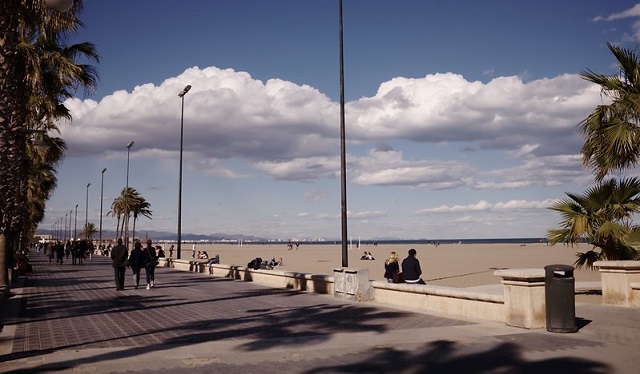
The area around Seville has fantastic natural and outdoors places, including the beautiful Atlantic beaches of Huelva and Cadiz (both about one hour drive from Seville), the Doñana natural park known for its wetlands and wildlife, the Sierra Morena mountains and the Alcornocales natural park.
Valencia has nice beaches on the Mediterranean sea, easily accessible from the old city center in just 40 minutes by public transportation.
Valencia or Seville: lodging
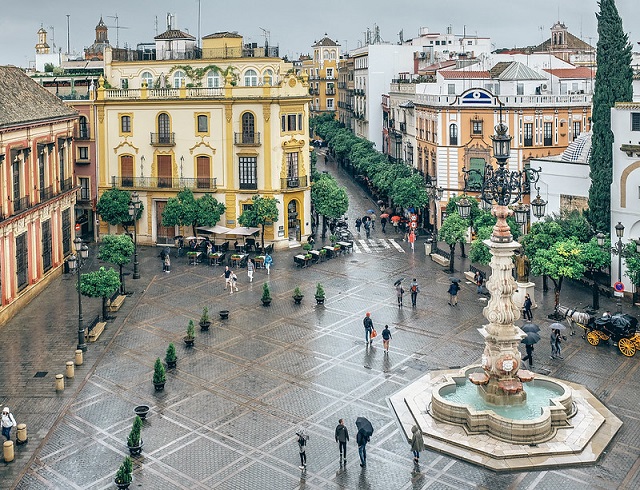
In Seville, most visitors stay in the Santa Cruz district, the old town and former Jewish quarter with its narrow cobbled streets and numerous countless monuments. The city center is quite compact and you can easily walk everywhere and find something different at every corner.
In Seville’s center, shops stay open late and there are bars and restaurants everywhere. There are countless hotels of all sorts with a wide price range, from 5-star hotels to small boutique places.
Some travelers recommend staying near the Alameda de Hercules, a large square lined with dozens of tapas bars with mostly locals. A more upscale alternative is the El Arenal district with its wide boulevards and elegant buildings.
Travelers often recommend Hotel Becquer and Hotel Amadeus which are centrally located and allow you to walk to most sights. For a hostel, La Banda Rooftop Hostel is also a recommended choice.
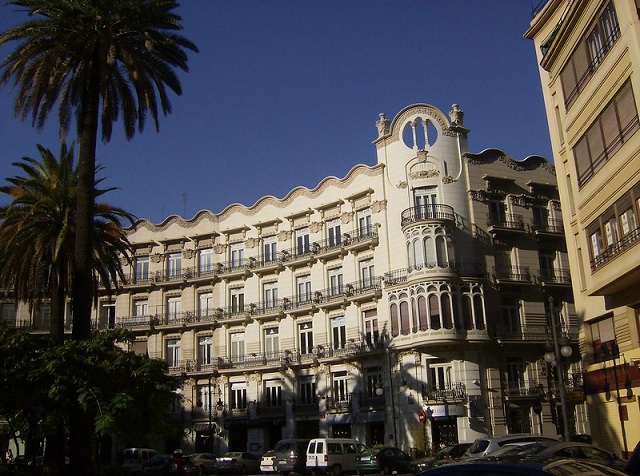
In Valencia, many travelers recommend staying near Mercado Colon, a central district close to the shopping and historic zone. It has a nice feel and is well-connected to other neighborhoods by subway.
For a more bohemian hippie vibe, the Barrio del Carmen near Plaza de la Virgen is a good choice. The nearby Centro Storico (historic center) is also a good option for lodging, e.g. during the Las Fallas festival in March.
The Westin Valencia, across the park from Mercado Colon, is often mentioned as being an excellent hotel.
The AC Colon (Mariott) has a central location close to bullring, City Hall plaza, walking streets. You can walk to other neighborhoods easily. It has nice modern rooms and good beds.
Hotel Ayre Astoria Palace is well-rated by travelers. Comfortable, quiet, and friendly, welcoming staff. The hotel is about a 10 minute walk from the train station and a 2 minute walk to the main square.
The Sorolla Centro is very convenient and easy to walk from to the principal train station and the main plaza. The hotel is very clean and comfortable, and very affordable.
Day trips
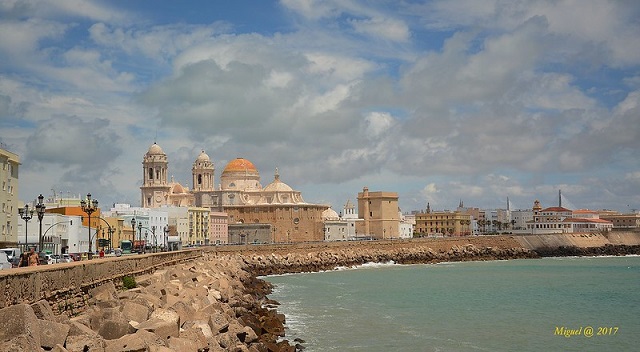
From Seville, you can easily visit Jerez, another great (albeit much smaller) city full of Moorish history, Flamenco, and horseriding tradition, about an hour drive from Seville.
The city of Cádiz with its centuries-old historic town and its fantastic beaches on the Atlantic ocean is also a great option for a day trip (1.5-hour drive).
From Seville, you can also catch the high-speed train to Cordoba (50 minutes) and visit the amazing Mezquita-Cathedral, a unique mix of Islamic and Catholic styles, and the astonishing old town. The city of Ronda, perched on high cliffs, is also a short bus ride from Seville.
From Valencia, you can easily catch a ferry to Ibiza and the Balearic islands,. You can also drive or catch a bus to the nearby pretty coastal city of Alicante, which has very nice beaches and an attractive old town within walking distance.
You can also head inland to Xativa, Sagunto, Aragon, or Teruel, all scenic towns worth a visit.
***
Photo credits:
(1) Featured: “Sevilla” (CC BY-SA 2.0) by kopretinka
(2) “Valencia” (Public Domain) by boklm
(3) “Seville” (CC BY 2.0) by Neilhooting
(4) “Seville” (CC BY 2.0) by Neilhooting
(5) “Sevilla” (CC BY 2.0) by enricrubioros1
(6) “València” (CC BY-SA 2.0) by David Poblador i Garcia
(7) “Valencia, Spain” (CC BY 2.0) by jafsegal
(8) “Capturing the Finale!” (CC BY 2.0) by Alcu3
(9) “Valencia” (Public Domain) by boklm
(10) “Valencia” (Public Domain) by boklm
(11) “Sevilla, Spain” (CC BY-SA 2.0) by szeke
(12) “Valencia” (CC BY-SA 2.0) by el_mm
(13) “Cadiz.” (CC BY 2.0) by Miguel. (respenda)

